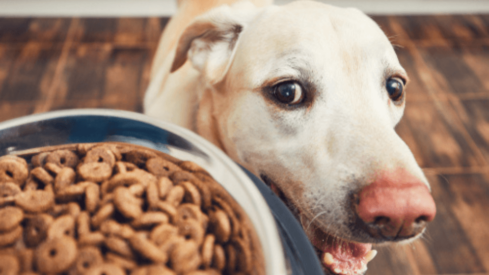Enhancing the taste of food for pets

Palatable foods combine flavors, aromas, appearance and consistency. But is one factor more important than another? And what is the role of sucrose and salt?
Besides being complete and balanced, the best diets must entice pets and their owners. According to scientific research, if a dog is unable to detect any scent, they lose the ability to discriminate between two diets – making aroma a primary factor in food palatability.
From the owner’s perspective, strong ‘meaty’ aromas should be avoided. Although these increase pet food palatability, they do not appeal to pet owners. So priority is better given to product appearance and ingredients that align with, for instance, current organic/natural trends in human diets.
New approaches
Considering dry pet food contains less than 20% moisture content and is primarily made of plant- based ingredients, its ability to stimulate the senses is lacking. That’s why pet food manufacturers have developed new approaches that satisfy pets and owners.
Early efforts to enhance palatability began by using amino acids and fats from organ meats to coat kibble. While this increases palatability, these fats react with oxygen and become rancid – significantly reducing shelf life. In addition, the pungent odor associated with organ coated kibble deters many pet owners.
With a growing understanding of food science, animal nutritionists started taking advantage of the Maillard reaction, the chemical reaction between amino acids and sugars occurring with high heat and responsible for browned and complex flavors. This is the same reaction that leaves coffee tasting robust and burgers tasting charred.
Accumulating data, however, suggested that by- products of the Maillard reaction led to decreased dietary lysine bioavailability – an essential amino acid – and increased risk of age-related diseases in pets. Another fact that would deter pet owners.
Multi-coated kibble
Now is the era of layering kibble with palatants: multi- coated kibble. The first coating is often a protein/ starch layer that provides the desired taste and texture for the pet, while subsequent layers focus on sealing aromas and making the kibble visually appealing to pet owners. Even probiotics and allergy-preventing antibodies are being layered onto multi-coated kibble.
Considering that dogs can detect all scents 10,000 to 100,000 times better than the average human, pet food manufacturers are using multi-coated kibble to their advantage. While strong aromas can still promote food palatability in pets, these are simultaneously masked for pet owners.
Emerging aromas
Instead of altering the core formulation of a diet to achieve the desired flavor, the logical approach is to add flavor-enhancing compounds directly into the kibble. Recently, pet food manufacturers have been using liquid aromas to improve palatability without affecting the nutrient profile.
The fact that every species will interpret scents differently does make developing aromas complex. Aromas that sound simple to replicate, like meat and cheese, are actually some of the most difficult to have accepted by both pets and humans.
A recent US patent filed by Applied Food Biotechnology Inc focuses on developing humanized aromas that appeal to pet owners – like ‘grilled’ and ‘sweet’ – while remaining palatable to dogs.
The role of sucrose
Another approach has been to exploit the ability of dogs to taste ‘sweet’. Unlike cats, dogs can taste sugar, and studies show that adding sucrose increases food selection and intake. However, adding more sucrose also raises a diet’s caloric content and is not sustainable. So instead, researchers are using natural compounds to increase the sweetness value of sucrose without the additional calories.
For example, ammoniated glycyrrhizin isolated from licorice root is 50x sweeter than sucrose, and when used in combination it increases the sweetness value of sucrose synergistically. These flavor-enhancement properties have been validated in dog food trials and offer a unique approach to increasing palatability in vegetarian diets.
Sodium compounds
Aside from flavor, sodium compounds can also improve food texture. For example, pyrophosphates, like sodium tripolyphosphate, are often used to increase palatability without significantly affecting dietary sodium intake. Although these compounds are common in human-grade processed meats, the long-term use of pyrophosphates can impair kidney function.
Just add salt?
Salt adds more than a ‘salty’ taste to our food. It also enhances the ability to taste sweet and umami flavors while suppressing bitterness. On this basis, salt is composed of sodium and chloride (NaCl), essential macrominerals needed in every diet to maintain body fluids and support proper organ and nervous system function.
Fruit and vegetables provide a substantial amount of chloride, while animal tissue and meats offer a significant source of sodium. This means additional salt is not usually required from a nutritional perspective, but may be added to reach adequate levels of sodium chloride (NaCl). Since there is no defined maximum NaCl intake, salt is often added to pet food as a palatant. The European Pet Food Industry Federation (FEDIAF) has only set minimum values, without a maximum limit:
Sodium = 0.10% – 0.12% DM*
Chloride = 0.15% – 0.17% DM*
*per 100 g dry matter (DM) in adult dogs
These requirements are similar for cats, and studies suggest that values up to 1.50% DM sodium and 2.35% DM chloride are safe for healthy adult dogs and cats.
Therapeutic function
Salt is not only used as a palatant – it also has a therapeutic function. Prescription veterinary diets utilize added salt to promote water consumption and flush the urinary system. This benefits conditions that affect the urinary tract by helping to dilute urine and to prevent urolith (urinary stone) formation. Several veterinary diets also offer treats with high salt content for this same purpose.
Unlike in humans, there is no causal link between elevated dietary salt intake and conditions like hypertension, cardiovascular disease and kidney failure in pets. That being said, the current recommendation is to avoid high salt intake in pets with a history of conditions like these, but actively limiting salt intake is not necessary.
